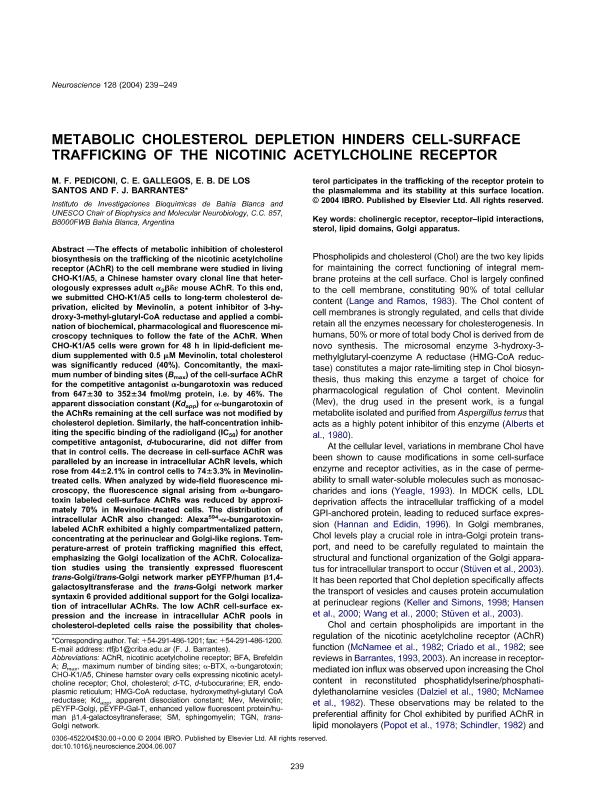Mostrar el registro sencillo del ítem
dc.contributor.author
Pediconi, Maria Filomena

dc.contributor.author
Gallegos, Cristina Eugenia

dc.contributor.author
de Los Santos, Elisa Beatriz

dc.contributor.author
Barrantes, Francisco Jose

dc.date.available
2018-07-24T19:49:37Z
dc.date.issued
2004-12
dc.identifier.citation
Pediconi, Maria Filomena; Gallegos, Cristina Eugenia; de Los Santos, Elisa Beatriz; Barrantes, Francisco Jose; Metabolic cholesterol depletion hinders cell-surface trafficking of the nicotinic acetylcholine receptor; Pergamon-Elsevier Science Ltd; Neuroscience; 128; 2; 12-2004; 239-249
dc.identifier.issn
0306-4522
dc.identifier.uri
http://hdl.handle.net/11336/53014
dc.description.abstract
The effects of metabolic inhibition of cholesterol biosynthesis on the trafficking of the nicotinic acetylcholine receptor (AChR) to the cell membrane were studied in living CHO-K1/A5, a Chinese hamster ovary clonal line that heterologously expresses adult α 2βδε mouse AChR. To this end, we submitted CHO-K1/A5 cells to long-term cholesterol deprivation, elicited by Mevinolin, a potent inhibitor of 3-hydroxy-3-methyl- glutaryl-CoA reductase and applied a combination of biochemical, pharmacological and fluorescence microscopy techniques to follow the fate of the AChR. When CHO-K1/A5 cells were grown for 48 h in lipid-deficient medium supplemented with 0.5 μM Mevinolin, total cholesterol was significantly reduced (40%). Concomitantly, the maximum number of binding sites (B max) of the cell-surface AChR for the competitive antagonist α-bungarotoxin was reduced from 647±30 to 352±34 fmol/mg protein, i.e. by 46%. The apparent dissociation constant (Kd app) for α-bungarotoxin of the AChRs remaining at the cell surface was not modified by cholesterol depletion. Similarly, the half-concentration inhibiting the specific binding of the radioligand (IC 50) for another competitive antagonist, d-tubocurarine, did not differ from that in control cells. The decrease in cell-surface AChR was paralleled by an increase in intracellular AChR levels, which rose from 44±2.1% in control cells to 74±3.3% in Mevinolin-treated cells. When analyzed by wide-field fluorescence microscopy, the fluorescence signal arising from α-bungarotoxin labeled cell-surface AChRs was reduced by approximately 70% in Mevinolin-treated cells. The distribution of intracellular AChR also changed: Alexa 594-α- bungarotoxin-labeled AChR exhibited a highly compartmentalized pattern, concentrating at the perinuclear and Golgi-like regions. Temperature-arrest of protein trafficking magnified this effect, emphasizing the Golgi localization of the AChR. Colocalization studies using the transiently expressed fluorescent trans-Golgi/trans-Golgi network marker pEYFP/human β1,4- galactosyltransferase and the trans-Golgi network marker syntaxin 6 provided additional support for the Golgi localization of intracellular AChRs. The low AChR cell-surface expression and the increase in intracellular AChR pools in cholesterol-depleted cells raise the possibility that cholesterol participates in the trafficking of the receptor protein to the plasmalemma and its stability at this surface location.
dc.format
application/pdf
dc.language.iso
eng
dc.publisher
Pergamon-Elsevier Science Ltd

dc.rights
info:eu-repo/semantics/openAccess
dc.rights.uri
https://creativecommons.org/licenses/by-nc-sa/2.5/ar/
dc.subject
Cholinergic Receptor
dc.subject
Golgi Apparatus
dc.subject
Lipid Domains
dc.subject
Receptor-Lipid Interactions
dc.subject
Sterol
dc.subject.classification
Otras Ciencias Biológicas

dc.subject.classification
Ciencias Biológicas

dc.subject.classification
CIENCIAS NATURALES Y EXACTAS

dc.title
Metabolic cholesterol depletion hinders cell-surface trafficking of the nicotinic acetylcholine receptor
dc.type
info:eu-repo/semantics/article
dc.type
info:ar-repo/semantics/artículo
dc.type
info:eu-repo/semantics/publishedVersion
dc.date.updated
2018-07-11T14:10:52Z
dc.journal.volume
128
dc.journal.number
2
dc.journal.pagination
239-249
dc.journal.pais
Estados Unidos

dc.description.fil
Fil: Pediconi, Maria Filomena. Consejo Nacional de Investigaciones Científicas y Técnicas. Centro Científico Tecnológico Conicet - Bahía Blanca. Instituto de Investigaciones Bioquímicas de Bahía Blanca. Universidad Nacional del Sur. Instituto de Investigaciones Bioquímicas de Bahía Blanca; Argentina. Unesco; Argentina
dc.description.fil
Fil: Gallegos, Cristina Eugenia. Consejo Nacional de Investigaciones Científicas y Técnicas. Centro Científico Tecnológico Conicet - Bahía Blanca. Instituto de Investigaciones Bioquímicas de Bahía Blanca. Universidad Nacional del Sur. Instituto de Investigaciones Bioquímicas de Bahía Blanca; Argentina. Unesco; Argentina
dc.description.fil
Fil: de Los Santos, Elisa Beatriz. Consejo Nacional de Investigaciones Científicas y Técnicas. Centro Científico Tecnológico Conicet - Bahía Blanca. Instituto de Investigaciones Bioquímicas de Bahía Blanca. Universidad Nacional del Sur. Instituto de Investigaciones Bioquímicas de Bahía Blanca; Argentina. Unesco; Argentina
dc.description.fil
Fil: Barrantes, Francisco Jose. Consejo Nacional de Investigaciones Científicas y Técnicas. Centro Científico Tecnológico Conicet - Bahía Blanca. Instituto de Investigaciones Bioquímicas de Bahía Blanca. Universidad Nacional del Sur. Instituto de Investigaciones Bioquímicas de Bahía Blanca; Argentina. Unesco; Argentina
dc.journal.title
Neuroscience

dc.relation.alternativeid
info:eu-repo/semantics/altIdentifier/url/https://www.sciencedirect.com/science/article/pii/S0306452204004750
dc.relation.alternativeid
info:eu-repo/semantics/altIdentifier/doi/http://dx.doi.org/10.1016/j.neuroscience.2004.06.007
Archivos asociados
